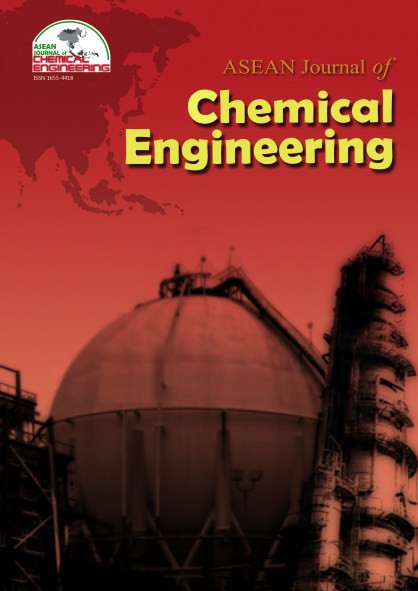Efect of pH on Growth, Spore Production and Spore Viability of Biocontrol Agent Trichoderma Harzianum in Submerger Fermentation
Abstract
The effect of pH medium on growth, spore production and spore viability of bicontrol agent Trichoderma harzianum were investigated in a batch farmenter in the range of 4 to 7. The biomass concentration of this fungus at pH 4,6 and uncontrolled pH were higher than at pH 5 and 7 after 18h incubation. The spore produced by the fungus at 6,7 and uncotrolled pH was higher than others. the highest level of spore production (6.67x107 spores/ml) occured at unctrolled pH, but the spore produced in the culture grown at 7 has a higher viability (52,5%) compared to those grown at other pH.References
Nameth, S. T., The Nut and Bolts of Bio-Fungicides, Florinet Floriculture Newsletter, 2001, vol. 8.
; Papavizas, G. C., and Lewis, J. A., Effect of Gliocladium and Trichoderma on Damping-Off of Cucumbers with Pythium nunn: Population Dynamics and Disease Suppression, Phytopathology, 1987, vol. 77 pp 335-340.
Stvan, A., and Chet, 1., Biological Control of Fusarium Crown Rot of Tomato by Trichoderma harzianum under field conditions, Plant Disease, 1987, vol. 71 pp 589-592.
Elad, Y., G., Chet, I. and Kantan, J., Trichoderma harzianum: A Biocontrol Agent Effective Against Sclerotium rolfsii and Rhizoctonia solani, Phytopathology, 1980, vol. 70 pp 119-121.
Harman, G. E., Jin, X., Stasz, T. E., Peruzzotti, G., Leopold, A. C. and Taylor, A. G. Production of Conidial Biomass of Trichoderma harzianum for Biological Control, Biological Control, 1991, vol, 1 pp 23-28.
Jackson, A. M., Whipps, J. M. Lynch J.M, Carbon and Nitrogen Sources on Spore Germination, Production of Biomass and Antifungal Metabolite by Species of Trichoderma and Gliocladium virens Antagonistic to Sclerotium cepivorum, Biocontrol Science and Technology, 1991, vol. 1 pp 43-51 (a).
Jackson, A. M., Whipps J. M. and Lynch, J. M., Nutritional Studies of Four Fungi with Disease Biocontrol Potential, Enzyme Microb. Technol, 1991, vol. 13 pp 456-461 (b).
Lewis, J. A., and Papavizas, G. C., Production of Chlamydospores and Conidia by Trichoderma SPP in Liquid and Solid Growth Media, Soil. Biol. Biochem., 1983, vol. 15, 351-357.
Pitt, D. And Poole, P. C., Calsium Induced Conidiation in Penicillium notatum in Submerge Culture, Transactions British Mycologial Society, 1981, vol. 76 pp 219-230.
Miller, G. L., Use of Dinitrosalicylic Acid Reagent for Determination of Reducing Sugar, Analytical Chemistry, 1959, vol. 31 pp 426-428.
Agosin, E., D., Volpe, G., Munoz, R., San Martin and Crawford, A., Effect of Culture Conditions on Spore Shelf Life of The Biocontrol Agent Trichoderma harzianum, World Journal of Microbiology & Biotechnology, 1997, vol. 13 pp 225-232.
Pedreschi, F and Aguilera, J. M., Viability of Dry Trichoderma harzianum Spores under Storage, Bioprocess Engineering, 1997, vol. 17 pp 177-183.
Jin, X., Harman, G. E. and Taylor, A. G., Conidial Biomass and Desiccation Tolerance of Trichoderma harzianum Produced at Different Medium Water Potentials, Biological Control, 1991, vol. 1 pp 237-243.
Bodo, B., S., Rebuffat, M., El Hajji, and Davoust, D., Structure of Trichoarzianines. A lic, an antifungal peptide from Trichoderma harzianum, Journal of American Chemical Society, 1985, vol. 107 pp 6011-6017.
Jin, X., Taylor, A. G. and Harman, G. E., Development of Media and automated liquid fermentation methods to produce desiccation-tolerant propagules of Trichoderma harzianum, Biological Control, 1996, vol. 7 pp 267-274.
Pedreschi, F., J. Aguilera, M., Agosin, E. and San Martin, R., Induction of Trehalose in Spores of the Biocontrol Agent Trichoderma harzianum, Bioprocess, Engineering, 1997, vol. 17, 317-322.
Copyright holder for articles is ASEAN Journal of Chemical Engineering. Articles published in ASEAN J. Chem. Eng. are distributed under a Creative Commons Attribution-NonCommercial 4.0 International (CC BY-NC 4.0) license.
Authors agree to transfer all copyright rights in and to the above work to the ASEAN Journal of Chemical Engineering Editorial Board so that the Editorial Board shall have the right to publish the work for non-profit use in any media or form. In return, authors retain: (1) all proprietary rights other than copyright; (2) re-use of all or part of the above paper in their other work; (3) right to reproduce or authorize others to reproduce the above paper for authors’ personal use or for company use if the source and the journal copyright notice is indicated, and if the reproduction is not made for the purpose of sale.



